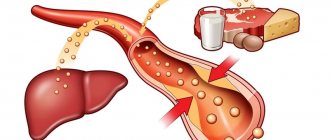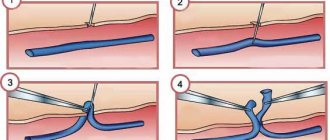Pharmacology
The drug belongs to a group of medications called statins - substances that help normalize cholesterol levels (high and low density) in the blood. The amount of reduction depends on the therapeutic dose selected by the doctor. The therapeutic effect is observed 14 days after the start of administration. By 4 weeks of using the drug "Rozart" the therapeutic effect reaches 90%.
Discussion: expert comments, live broadcasts with participating cities
Answers to the question on the symposium “Algorithms for rational therapy of atherosclerosis.”
00:00
Andrey Vladimirovich Susekov , Doctor of Medical Sciences, Professor:
– Dear colleagues, we don’t have much time for discussion.
Question: Is it possible to divide statins in half if the tablet does not contain a break mark? Do I need to take a break of 3 months in the summer?
It is better not to divide, because the companies' instructions indicate that the division process may interfere with the dose of the drug. There is a world experience “every other day”. Like diuretics. "Rosuvastatin" 10 mg - Monday, Wednesday, Friday or 80 mg once a week. But there is a remark. It is not a fact that such a regime reduces risks.
Is it necessary to take a break of 3 months in the summer? I think, my personal opinion, it’s possible. This is not in the recommendations. Drac Holiday is a medicinal holiday for people who have been taking statins for decades. Your opinion, Oksana Mikhailovna.
Oksana Mikhailovna Drapkina , executive director of the Internet session, secretary of the interdepartmental council on therapy of the Russian Academy of Medical Sciences:
– I absolutely agree with you. There are recommendations. We follow them.
Andrey Susekov : Viktor Savelyevich, do you think it’s possible to divide a statin tablet in half? Our listeners ask.
Viktor Savelyevich Gurevich , Doctor of Medical Sciences, Professor:
– I will join the opinion that you have already voiced, Andrei Vladimirovich.
Regarding the holidays of taking statins during the summer holidays. But if you just give the statins a break from the patient. No need to interrupt, it seems to me.
Andrey Susekov : Good remark. Thank you.
Rostov-on-Don, Ushakova Irina.
Question: What place do bile acid secretrates currently occupy in the treatment of dyslipidemia?
Very necessary for children and pregnant women in Russia, unfortunately, are not registered. There was Questran. As far as I know, Colesevelam up to 3.5 mg per day now has a good reputation in the world. But it is not registered in Russia.
Oksana Mikhailovna? Viktor Savelyevich?
Victor Gurevich : Several dosages, even more. But Colesevelam, I think, is a drug with promise.
02:25
Andrey Susekov : Thank you. Further.
Question: If, when prescribing statins, total LDL cholesterol is at the lower limit of normal, can statins be given at half the dose?
My answer and position is that I am not in favor of half and low doses. Now at the cardio center (I’m expanding the answer to the next question) in the laboratory of clinical epidemiology, we are starting a program for increasing statin doses in clinical practice and clinical studies of Atorvastatin 80 mg and Rosuvastatin 40 mg. The dose was 10 mg. I wouldn't do this. At half dose.
There is also the Finnish phenomenon of statin and scape, when, with long-term use, cholesterol begins to increase. Here, on the contrary, you need to add doses, but not reduce them. What do you think, Oksana Mikhailovna?
Oksana Drapkina: The recommendations tell us to do this. But, to be honest, there are such patients internally that they go on 5 mg. I don't always increase to 10 mg. These are, of course, strong statins. "Rosuvastatin" is meant.
Andrey Susekov : There is a certain niche for Rosuvastatin, because it is the most powerful statin.
Question: A young woman with autoimmune thyroiditis and xanthelasmas has normal total LDL cholesterol and triglycerides. But a high level of good cholesterol. What to do?
3 times more. The case is non-standard. Here it is necessary to exclude a deficiency of the protein that transports cholesterol esters. This is an extremely rare situation. You need to look at either the activity or the mass of STP using special methods. But our laboratory capabilities are limited.
In such patients, you probably need to look at the global risk Score. If it is high, then we prescribe statins, regardless of the lipid profile. I would also order AP-1 protein here, which, according to the literature, has a better indicator of reverse cholesterol transport than high-density cholesterol.
Victor Savelyevich, your opinion. High level of good cholesterol, what should be excluded and further examined here?
04:55
Viktor Gurevich : You remember well, Andrey Vladimirovich, the failures that occurred when increasing alpha cholesterol with the help of Torsetrapib. It turned out that this was of purely academic interest. We need to look at what sulfation of alpha-CS is the first.
Second. Sometimes this situation can occur with low triglyceride levels, low release of 3-beta from the liver. Should probably use the suggestions you made.
Perhaps this is the most important thing - to focus on cardiovascular risk. There is no need to be alarmed by the numbers alpha-HS 2 and above.
Andrey Susekov : Thank you very much. A very good point. With beta this is a subject for future research. Now in Russia, active research is beginning on new drugs that increase the level of alpha-cholesterol. RVX-08 injection forms. Future will tell.
Question: Statins for oncological negligence and oncological diseases. Clinicians often do not prescribe statins to this group of patients. Is this justified?
A difficult question, multidisciplinary. But we have a very experienced person in the audience. Your opinion please.
Vladimir Trofimovich Ivashkin , academician of the Russian Academy of Medical Sciences, Doctor of Medical Sciences:
– I think patients with cancer should not be prescribed statins. Any tumor is a glucose trap. In such patients, taking into account prognostic factors, there is no point in prescribing statins.
The side effects that these patients typically experience during chemotherapy or radiation therapy (in particular, the development of myocardial infarctions, which we see with radiation therapy for lung or breast tumors) are not due to an increase in cholesterol. There we are talking about a direct damaging effect on blood vessels and the development of endothelial pathology.
It is endothelial pathology that determines the possible development of thrombosis in such patients. I think there is no point in prescribing statins here.
07:45
Oksana Drapkina : I wouldn’t risk it. A patient with cancer has many problems. He probably has a chance to die from his cancer. This is the case when people no longer die from cardiovascular pathology.
Andrey Susekov : Viktor Savelyevich, I know that you have extensive experience in clinical lipidology. Have there been such compromising patients in your practice?
Victor Gurevich : I completely agree with the statements that have been made now. Absolutely correct. At the same time, one must keep in mind the first thing: the presence of cancer at different stages and in different locations is not an absolute contraindication for the prescription of statins. Here we must refer to cardiovascular risk.
For example, liver cancer or liver metastases are a direct contraindication. But if the cancer is stage zero at a different cancer location, if this is a patient with cardiovascular disease, then the cardiologist and oncologist should consider these problems and so on. I don’t develop the idea further. I think my colleagues also share the same point of view, taking into account the above.
Andrey Susekov : I literally have half a minute of remarks. We had a very seriously ill patient from Vologda. She, unfortunately, died. With severe familial hypercholesterolemia. While on high doses of statins, she developed breast cancer in one study. Mastectomy, chemotherapy.
We were afraid, doubted, consulted with foreigners. The opinion was that there was a cardiovascular risk, operations were performed and chemotherapy courses were completed. We returned to statin therapy, but in lower doses. This was such an interesting case.
Last question. Rostov-on-Don.
09:48
Question: How effective are generics of Rosuvastatin? In particular, "Mertenil".
Our guest has the floor. Do you have experience at Mertenil, Viktor Savelyevich? Your opinion on how ready we are for broader recommendations for generic Rosuvastatin. On the market for two years already.
Victor Gurevich: How do generics or generics appear, as they say now? Firstly, because the original drug is good. Secondly, because the license and protection period has passed. We must be good about the emergence of generics - number one.
As for Mertinil specifically. This is the second year we have been using it together. Absolutely positive result so far. The only thing we lack is an additional Russian post-registration study so that we can confirm our own ideas about this drug.
Andrey Susekov : I agree. Our laboratory also has good experience with Mertinil. But for objectification, Russian research is needed. They are scheduled at the heart center. This is probably the subject of our next conversation, colleagues. The drug is really good.
Oksana Drapkina : I will join. Probably everything.
Andrey Susekov : Thank you very much, dear colleagues, for being with us and taking an active part in our session. Not all issues were included in the regulations. But we promise you that by e-mail, according to technical capabilities, we will definitely answer all these questions.
Thanks a lot.
11:52
Source: https://internist.ru/publications/detail/diskussiya:-kommentarii-ekspertov,-pryamye-vklyucheniya-s-gorodami-uchastnikami9/
Indications for use
There are several reasons to start using the drug, taking into account the required dosage. Namely:
- Prevention and treatment of atherosclerosis.
- If the diet is not effective in reducing excess cholesterol levels.
- Excessive levels of lipids in the blood.
- I or II degree of elevated cholesterol levels.
- Prevention of cardiovascular diseases in people at risk. We are talking about men over 60 and women over 50.
- Reducing the likelihood of recurrent stroke or heart attack.
- Elevated levels of C-reactive protein in the blood.
- Reduced levels of good cholesterol.
- Stably elevated blood pressure.
- Prevention of pathological changes in the functioning of the heart and blood vessels caused by addiction to tobacco and alcohol.
The hereditary factor completes the list of indications for prescribing Rozart tablets.
Indications for use
“Rozart” is prescribed for exacerbation of chronic ailments of a cholesterol nature and to relieve the consequences of diseases of the cardiovascular system.
- hypercholesterolemia is an increased cholesterol level in the blood (leads to obesity, ischemia, atherosclerosis, cholelithiasis);
- hereditary hypercholesterolemia (also called familial) - an increased concentration of lipids is caused by a disorder in chromosome 19, inherited from one or two parents at once;
- hypertriglyceridemia - an abnormally high amount of fats in a person’s blood;
- to stop the progression of atherosclerosis;
- prevention of vascular and heart diseases, as well as complications after them (stroke, heart attack, coronary artery disease)
Instructions
The dosage is selected by the doctor. In the absence of a pronounced clinical picture, the physician prescribes 5 to 10 mg 1 time per day. A similar dosage is indicated when it comes to the use of multiple therapeutic agents for the treatment of cardiovascular diseases. 4 weeks after the start of the course, the dosage can be increased, subject to appropriate medical advice. Other practical recommendations for admission are as follows:
- patients with a chronic form of the pathology take 40 mg of the drug once a day;
- patients over 70 years of age take no more than 5 mg of the drug per day.
Attention! The tablet is swallowed whole, then washed down with water. There is no need to chew the medicine. The course is not tied to the time of day or meals. In addition to using the tablets prescribed by the doctor, the patient must follow the recommended dietary course.
Contraindications
Doctors identify several conditions in which the use of Rosart tablets is not allowed
Namely:
- work that requires constant concentration;
- failure of the liver;
- patient age under 18 years;
- period of pregnancy and breastfeeding;
- individual intolerance and hypersensitivity to certain components;
- individual lactose intolerance;
- the presence of pronounced muscle pathologies;
- the drug should not be used by women of reproductive age without additional protective equipment;
- It is prohibited to use Rosart and Cyclosporine tablets.
Important! Only after a comprehensive assessment of the patient’s health status will the person in the white coat decide on the advisability of using the drug.
Consequences of overdose and side effects
The medical community has no information about the negative consequences for the body of excessive use of the drug 1-2 times. If the patient consistently exceeds the dosages specified by the doctor, problems can make themselves felt:
| Gastrointestinal tract | Constipation, pain in the lower abdomen, attacks of nausea. In extremely rare cases, hepatitis develops. |
| Circulatory and lymphatic system | Increased likelihood of blood clots. |
| Musculoskeletal system | Necrosis of bone tissue, resolution of joint tissue, tendon rupture. |
| CNS | Migraine attacks, dizziness, memory loss, poor sleep, development of depression. |
| The immune system | Hives, itching and swelling. |
| Respiratory system | Attacks of coughing and shortness of breath. In extremely rare cases, pulmonary failure develops. |
| Urinary system | The appearance of blood impurities in urine. |
| Mammary gland | Pathological changes in shape. |
| Dermatology | In extremely rare cases, redness appears. |
| Endocrine system | Increased blood glucose levels, development of diabetes symptoms. |
If a person experiences even a slight malaise while taking Rosart tablets, you need to talk to your doctor. If necessary, the doctor will adjust the dosage or prescribe another drug.
Contraindications
Main contraindications to the use of Rozart:
- Hypersensitivity to the drug.
- Liver diseases.
- Unexplained increase in serum transaminase concentrations.
- A disease of skeletal muscles with the destruction of muscle fibers.
- People over 70 years of age.
- Alcohol abuse.
- Renal dysfunction.
- Hypothyroidism.
- History of hereditary muscle disorders.
- Situations in which elevated blood levels of the drug are observed, for example: in Asian patients.
- Concomitant use of fibrates.
For mild to moderately impaired liver function and severe renal impairment, the drug should not be used at a dose of 40 mg in elderly patients.
Kidney disorders
Conditions for dispensing from pharmacies
The cost of a prescription drug in a pharmacy chain depends on the number of tablets and dosage. Price in different regions:
- “Rozart” 10 mg (30 tablets) – 490-550 rubles;
- “Rozart” 10 mg (90 tablets) – 1200-1290 rubles;
- “Rozart” 20 mg (30 tablets) – 690 – 732 rubles;
- “Rozart” 20 mg (90 tablets) – 1770-1820 rubles;
- “Rozart” 40 mg (30 tablets) – 1050-1098 rubles;
- “Rozart” 40 mg (90 tablets) – 2000-2350 rubles.
If necessary, patients have the opportunity to purchase not the entire package, but a certain number of tablets. Regardless of the choice, the tablets are stored in a place protected from light until the date indicated on the package - up to 2 years.
Side effects
In early studies with daily doses ≥8 mg, there were a few cases of rhabdomyolysis. More recent studies have not used doses greater than 40 mg per day.
When using Rozart, side effects are observed, as when using statins. Myalgia, joint pain, headache, gastrointestinal symptoms: diarrhea or constipation and nausea often occur.
In the aforementioned long-term LIVES study, the most common negative symptoms were increases in creatine phosphokinase (2.7%), transaminases (1.5 to 1.8%), and gamma-GT (1%). Increases in liver enzymes were slightly more common in these studies than among other statins.
Proteinuria was more common in these studies (8.1%) (among other statins: 7.5%). Two cases of rhabdomyolysis occurred in the LIVES study (one of which was equivocal); this long-term study used daily doses of 10 or 20 mg of Rosart.
In the UK, the Food and Drug Administration has looked at the issue of rhabdomyolysis in detail; According to their report, between 2003 and 2008, there were 51 cases of rhabdomyolysis (37 severe) associated with the use of Rosart.
Another harm that Rosart caused to patients was a change in the amount of blood elements. Research methods have established that it has an effect on erythropoiesis and leukopoiesis. Therefore, patients suffering from anemia should exercise increased caution when using the drug in the long term. Rosart in these cases should be taken only after careful consideration of the benefits/harms by the treating doctor.
Analogs
If the patient has severe contraindications, the doctor prescribes an analogue medicine. The list of these is as follows:
- "Tevastor";
- "Rosucard";
- "Rosuvastatin";
- "Zokor";
- "Simvakol";
- "Actalipid";
- "Rosiestark";
- "Medostatin";
- "Lipostat";
- "Mertenil";
- "Rozulip";
- "Choletar."
Important! Before using an analogue drug, you should read the attached instructions and the doctor’s advice.
Rosuvastatin tablets can be divided
Rosuvastatin tablets are designed to reduce the production of your own cholesterol in the body.
When the levels of this organic compound in the blood increase, the risk of developing atherosclerotic changes in capillaries, cardiac ischemia, heart attack and stroke increases significantly.
Therefore, proper therapy is important in the initial stages, as soon as test results show elevated total cholesterol levels.
In the initial stages, when the excess of the permissible norm is small, the patient is prescribed a special diet with limited fatty foods. Thus, the use of lipid-lowering drugs, such as Rosuvastatin, gives the maximum effect. This material covers selected instructions for using the drug.
Composition and effect of the drug, indications for use
The tablet prescription in Latin is written as Rosuvastatin. The drug belongs to the group of lipid-lowering drugs (statins) and is an inhibitor of HMG-CoA reductase. Designed to reduce the production of own cholesterol by liver tissue and reduce the volume of harmful lipoproteins (having a low density) in the blood plasma.
One tablet, coated with a soluble film coating, contains the active component of rosuvastatin calcium (in a dosage of 5 to 40 mg) and excipients in the form of cellulose, calcium dihydrate, magnesium stearate, povidone, corn starch and others. Manufacturers of the original drug Rosuvastatin are Russian pharmaceutical companies, JSC Vertex, LLC Izvarino Pharma.
Foreign manufacturers of drugs based on the substance rosuvastatin AstraZeneca, Gedeon Richter, KRKA, TEVA and others. The tablets can be stored for 3 years from the date indicated on the cardboard package at a temperature below 25 o C. Rosuvastatin is dispensed from pharmacies by prescription.
Indications for use:
- new-onset hypercholesterolemia;
- familial hypercholesterolemia of the heterozygous or homozygous type;
- high concentration of triglycerides in blood plasma;
- pathological state of capillaries in connection with manifestations of atherosclerosis, including progression of the disease (as a measure of complex treatment);
- prevention of cardiovascular diseases, including in elderly patients.
Medicines of the statin group are prescribed to patients who have not been helped by a diet combined with increased physical activity, frequent exposure to air, and quitting smoking and drinking alcohol.
Instructions for use and dosage
Taking the drug is not associated with eating food; there is no need to think about taking pills before or after meals. It is advisable to take Rosuvastatin at night, since at night the body's own cholesterol production increases. But such a measure is not necessary; it is enough to simply take the drug once every 24 hours without skipping, at approximately the same time.
According to the official instructions for use, before starting to use the tablets, the patient is prescribed a low-fat diet so that the therapy brings maximum effect. The patient should limit the amount of salty, hot and spicy foods, refuse food containing large amounts of animal fats, carbonated drinks, baked goods, sausages, canned food and ready-made sauces.
You need to introduce as much fiber, vegetables and fruits into your diet as possible. Such a balanced diet should be maintained not only during the course of statin treatment, but also after its completion. The initial dosage recommended by doctors for patients for initial use or transferred to Rosuvastatin from other lipid-lowering drugs is 5–10 mg for 24 hours.
But the selection of the initial dose is made finally, based on the results of biochemical blood tests. The specialist also takes into account the patient’s risk of developing consequences from the heart and capillaries - heart attack, ischemia, heart failure.
If there are no side effects from using Rosuvastatin, the dosage can be increased if necessary after four weeks.
If the result of taking tablets at a dosage of 20 mg does not provide a therapeutic effect or the cholesterol level as a result of the analysis is several times higher (for example, with familial hypercholesterolemia), the doctor prescribes Rosuvastatin at a dose of 40 mg per day and takes the patient under control.
The same dose is prescribed for people at high risk of heart complications. If the patient has not previously contacted specialists, has undergone examination and has not taken statin drugs, he should not be prescribed 40 mg tablets per day at once. Every two weeks during the course of therapy, the patient is advised to donate blood for biochemistry in order to monitor cholesterol levels over time.
Patients suffering from moderate or mild renal failure can take Rosuvastatin at an initial dosage of 5-10 mg. If these disorders are moderate or severe, statins are not prescribed. For liver diseases occurring in acute or chronic form, then during the acute stage, the use of Rosuvastatin is contraindicated.
Is it possible to divide the tablet in half, many patients ask, who are prescribed, for example, a dose of 10 mg per day, but the pharmacy only has a 20 mg release form. Firstly, when dividing the pills, the dosing accuracy may not be observed; this point is especially important for patients whose body reacts violently to even a slight excess of the specified dose.
Secondly, most tablets from the statin group, including Rosuvastatin, are coated with a soluble film coating. It protects the active components from the action of gastric juice. If the integrity of the tablet is violated, the components of the medicine enter into an undesirable reaction with the acidic environment of the stomach.
And the third problem is the impact of environmental factors on the divided tablet itself (light, humidity and heat). If half of such a pill has been left for several days, it may lose its medicinal qualities.
The instructions for use of Rosuvastatin indicate that the tablet should not be chewed. Accordingly, it is undesirable to divide it into parts.
It is better to buy a drug with a good shelf life in the required dosage and take it as recommended by the treating doctor.











